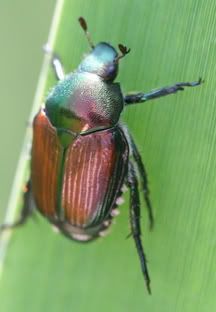
Posted on 03/08/2010 11:48:24 AM PST by decimon
Geraniums may hold the key to controlling the devastating Japanese beetle, which feeds on nearly 300 plant species and costs the ornamental plant industry $450 million in damage each year, according to scientists with the Agricultural Research Service (ARS).
The beetle, Popillia japonica Newman, can feast on a wide variety of plants, including ornamentals, soybean, maize, fruits and vegetables. But within 30 minutes of consuming geranium petals, the beetle rolls over on its back, its legs and antennae slowly twitch, and it remains paralyzed for several hours. The beetles typically recover within 24 hours when paralyzed under laboratory conditions, but they often succumb to death under field conditions after predators spot and devour the beetles while they are helpless.
ARS entomologist Chris Ranger at the agency's Application Technology Research Unit in Wooster, Ohio, is working on developing a way to use geraniums to control the beetles.
Ohio and neighboring Michigan are some of the largest producers of horticultural plants, most of them grown in greenhouses. Other research to benefit the horticultural industry includes that of Susan Stieve, curator of Ohio State University's Ornamental Plant Germplasm Center in Columbus, Ohio.
Stieve is working with OSU collaborators and horticulturist Jonathan Frantz of the ARS Greenhouse Production Research Group in Toledo, Ohio, to see whether a specialized breed of begonias can tolerate colder temperatures.
The scientists are screening the begonias at two production temperatures: 5 degrees Fahrenheit colder than normal, and 10 degrees F colder than normal. Begonias are found naturally in a wide variety of climates and altitudes—ecological clues that can be used to identify promising germplasm. Being able to grow begonias at cooler temperatures could reduce greenhouse heating bills for ornamental growers in northern climates.
###
Read more about this research in the March 2010 issue of Agricultural Research magazine.
ARS is U.S. Department of Agriculture's principal intramural scientific research agency.
USDA is an equal opportunity provider, employer and lender. To file a complaint of discrimination, write: USDA, Director, Office of Civil Rights, 1400 Independence Ave., S.W., Washington, D.C. 20250-9410 or call (800) 795-3272 (voice), or (202) 720-6382 (TDD).
Grub control is a key to eliminating Japanese beetles. Bayer makes a chloro-nicotinic, imadacloprid, which is an excellent turf grub insecticide.
Geraniums smell kinda funny. Can’t narrow it down any farther.
This is very true....last summer while watering my lovely bright red geraniums and “dead heading” the old blooms, I noticed 2-3 Japanese beetles inside the old dead blooms and leaves....on their backs....feet straight up in the air...if you could condense the “oil” of the geranium plant into a plant spray....someone could be very, very wealthy....
Ping to the Weekly Gardening Thread
Venus beetletrap geranium?
Even when the beetles are stunned, they probably aren’t choice edibles. I have never seen birds going after them. I used a tweezer to offer one to a praying mantis - after ten minutes of indifference it speared the beetle - took one taste and madly shook it off its claw. Dunk and stomp works best for control (no spraying in the butterfly and hummingbird garden) but even the ants get sick of the offering after a few days.
You could mix your own - essential oils go a long way.
Unless you treat the whole neighborhood, grub control isn’t that effective.
I like geraniums, but my chickens control Japanese Beetles just fine. I set my beetle traps up so that the beetles fall into the chicken house where the biddies just gobble ‘em up. An added benefit is that it contributes quite a bit of protein to the eggs. My beetle problem has declined significantly every year since I began doing this three years ago.
For those of us who can’t or won’t have chickens, geraniums could be the way to go.
I’ll try them this year.
Are Japanese beetles those little bugs that look like Lady Bugs but are green instead?
What a coincidence. That’s exactly what Obamatrons do after seeing The Messiah on TV.
I’ve read recently that four o’clocks are also good for fighting japanese beetles. Kind of a “pretty poison” in the beetle world. The beetles love the taste, but it kills them.
Good luck. Let me know how it turns out.

I love four o’clocks. They’re a great annual. Time to plant a bunch of those as well.

Disclaimer: Opinions posted on Free Republic are those of the individual posters and do not necessarily represent the opinion of Free Republic or its management. All materials posted herein are protected by copyright law and the exemption for fair use of copyrighted works.